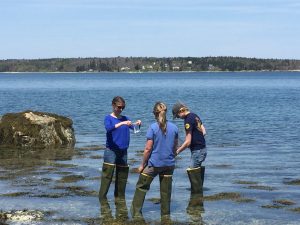EPA Recreational Waters Conference
As part of the New England Sustainability Consortium project work, Kathleen Bell of the UMaine School of Economics, her master’s student Abigal Kaminski, and Keri Kaczor of UMaine Cooperative Extension recently attended the 2016 EPA Recreational Waters Conference in Washington, D.C. where Kaminski presented a poster titled “An Economic Evaluation of Safety Information on Coastal Beaches.” The poster was based on a paper of the same name authored by Kaminski, Bell, Caroline Noblet, and Keith Evans. Below, Kaminski provides a summation of their work.
In this study, we used data from a survey of beachgoers in Maine and New Hampshire to explore factors impacting their decision to seek out water quality and surf conditions safety information.

In our sample, beachgoers sought surf conditions information at a higher rate than water quality information, which suggests that beachgoers may view the risks associated with each differently.
The findings provide valuable insight for coastal resource managers and public health officials who are responsible for monitoring water quality on coastal beaches and communicating when these waters may be unsafe for swimming. Knowing whether beachgoers seek out information, and which beachgoers choose to do so, is interesting and important to informing these officials’ work. They can use our findings to tailor their communication methods to reach a broader group of people, by changing either where or how they communicate information.
Surf conditions versus water quality information
When looking closely at our data, we can separate those who sought safety information into three groups: those interested only surf conditions information; those wanting both surf conditions and water quality; and, those who sought out only water quality information only.
In our sample very few people sought out water quality information only, which is not unexpected. The risks associated with swimming in dangerous surf conditions include death, while the risks associated with swimming in contaminated water are typically less dire.
To me, it is important that people understand their risks when they go to the beach, and that the choices they make are done in the context of safety information. I’m not sure exactly how we can better communicate safety behavior so that more people seek it out or know where to find it, but I think that knowing more information about beachgoer safety information-seeking behaviors is one step towards creating or supporting more effective safety communication programs.
Presenting this work at the EPA Recreational Waters Conference was a good first step in addressing these issues. The conference was attended by many people who are responsible for monitoring and communicating water quality conditions on our nation’s beaches. In Maine specifically, we continue to work with Keri Kaczor of Maine Healthy Beaches to help assess their communication plan.
Student perspective on national conference
I found the EPA conference particularly interesting for two reasons.
First, it allowed me to share my work and receive feedback from people who are deeply invested in recreational water quality. Through this I got a better understanding of diverse monitoring and communication programs across the nation. This helps me better place my work in a national context.
Second, I will be graduating and looking for a job after this summer. At the conference I got to talk to people in many different positions and get a better idea of what their job responsibilities are day-to-day and what their paths to their current careers have been. This kind of insight is incredibly useful and helps me to better understand how the skills I’ve built in my master’s program, as well as my personal interests, could support my future career path.
